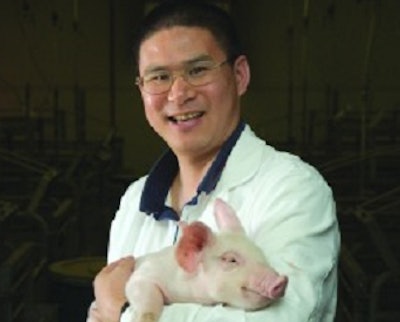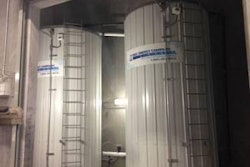
Glutamate, an abundant amino acid found in milk and meat, is getting a closer look by Dr. Guoyao Wu, a Texas A&M AgriLife Research scientist and distinguished professor in the department of animal science at Texas A&M University. Wu’s research suggests a diet containing sufficient glutamate can aid both animals and humans.
Glutamate can aid the production of milk by lactating females (for example pigs and women), while improving breeding success rates of sows and providing nutrition in newborn pigs.
“When I first came to Texas A&M, everyone in the field of animal nutrition knew about amino acids, but there was no data on glutamate,” Wu said. “That’s why I wanted to develop methods for glutamate analysis and gather data, while conducting my primary research on biochemistry and nutrition of protein and amino acids.”
Glutamate was also in the spotlight in October 2013 in Galveston at the 13th International Congress on Amino Acids, Peptides and Proteins.
“There were more than 200 people from 34 countries attending,” Wu said. “That’s where glutamate really began to be discussed more in-depth among nutrition scientists. We walked away with some great ideas and momentum going forward.”
Most recently, Wu discussed the merits of glutamate as a functional amino acid for animals and humans at a conference on December 12 in New York, “Frontiers in Agricultural Sustainability: Studying the Protein Supply Chain to Improve Dietary Quality.”
Sow’s milk is rich in free glutamine and glutamate. Wu said these two amino acids, together with branched-chain amino acids and proline, are important to stimulate protein synthesis and mammary growth.
The gut plays a key role in determining the provision of dietary amino acids to extra-intestinal tissues in animals, Wu said.
“It’s (widely) believed that glucose is the only energy source for the gut, but it is not true,” Wu said. “It’s glutamate, along with its metabolites glutamine and aspartate. Until recently, Texas approved glutamate as a supplement for animal use, and its benefits are that it aids lactating, weanling and pregnant animals.”
Wu said another component of his research will include incorporating glutamate into diets of lactating mothers. He gave a presentation recently at Japan’s Kumamoto International Conference on Breastfeeding. He said that worldwide breastfeeding among women with infants is less than 50 percent.
“Glutamate accounts for 10 percent of amino acids in milk protein,” he said. “That’s why I think it is all tied to diet.”
To increase lactation and get more glutamate in the gut, Wu said foods rich with glutamate such as seafood, meat and pork feet can be consumed.
Scientists at Ajinomoto Inc. (Japan) found that glutamate also improves appetite. The human tongue has receptors for glutamate, Wu said.
Meanwhile, in Wu’s laboratory in College Station, he has developed new enzymatic methods to determine glutamate in proteins of foods such as meat, milk and plant products. After hydrolysis by digestive enzymes, the samples are run through a High Performance Liquid Chromatography machine to separate and quantify glutamate.
“Glutamate has many benefits for humans, specifically lactating females,” Wu said.
Though there are concerns that sodium glutamate in diets is bad for animals and humans, he said, moderate levels of this nutrient from dietary supplementation or protein can be beneficial. Results of recent studies by Wu and colleagues at Texas Veterinary Medical Diagnostic Laboratory indicate that dietary supplementation with as high as 4 percent sodium glutamate (4 grams sodium glutamate per 100 grams food) is safe in growing pigs.
Wu said there’s also a misconception that dietary glutamate causes brain injury.
“It’s not true,” he said. “Almost all of glutamate in the diet is catabolized by the small intestine to fulfill its important physiological and nutritional functions. In pigs and humans, very little dietary glutamate enters the blood circulation. This is very different than the direct injection of glutamate into the brain, which bypasses intestinal metabolism.”
Wu said he plans to continue his glutamate research with weanling, lactating and gestating swine, and study how glutamate enhances protein synthesis in the small intestine and mammary tissue. He also wants to broaden the work to include human lactation and infant formula.















